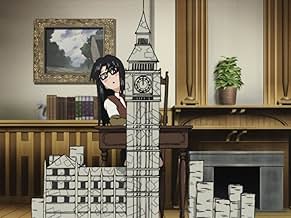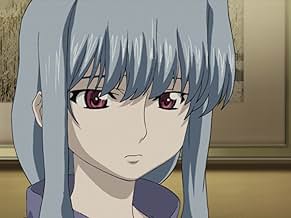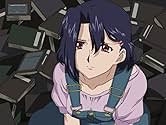Agrega una trama en tu idiomaNenene, a famous female writer, hires the Paper Sisters, so named due to their ability to manipulate and control paper, as bodyguards.Nenene, a famous female writer, hires the Paper Sisters, so named due to their ability to manipulate and control paper, as bodyguards.Nenene, a famous female writer, hires the Paper Sisters, so named due to their ability to manipulate and control paper, as bodyguards.
Explorar episodios
Opiniones destacadas
I'm not sure if the person below has only seen the first 10 episodes, or the entire series, but either way I completely disagree with him.
As an anime fan, I have to say R.O.D. is perhaps one of the most gorgeously drawn and well written animes of all time. It might start out slowly for some, but once it picks up it truly becomes enthralling. R.O.D. The TV offers more in depth characters and subplots (which were lacking in the Read or Die OVA). The plot focuses around 3 sisters who are all paper users and a Japanese author. The characters from the OVA show up as the series progresses.
I highly recommend the anime for all fans. You do not need to see the OVA, but the second half of the series will make more sense with it.
As an anime fan, I have to say R.O.D. is perhaps one of the most gorgeously drawn and well written animes of all time. It might start out slowly for some, but once it picks up it truly becomes enthralling. R.O.D. The TV offers more in depth characters and subplots (which were lacking in the Read or Die OVA). The plot focuses around 3 sisters who are all paper users and a Japanese author. The characters from the OVA show up as the series progresses.
I highly recommend the anime for all fans. You do not need to see the OVA, but the second half of the series will make more sense with it.
Read or Die: TV has few action scenes throughout all its 26 episodes, but when it occurs, it's really memorable and fantastic. i really love Read or Die: TV. The characters are very appealing, especially the character named Maggie. The paper manipulation, which is the power to manipulate paper (obviously), is amazing to watch and quite a interesting idea of a power. The music creates a fun spy mood that intensifies the actions scenes when they occur. And the art and animation I found to be really nice; i really like the character art; it just appeals to me. The colors, the look, everything is just beautiful to my eye. Read or Die: TV seems to concentrate more on developing the characters and story more than the OVA, which is very welcoming even though it creates a slower pace than the OVA. Still, this is a fantastic anime series and is one of my top favorites. Excellent action (when it occurs), wonderful music, beautiful art, lovely characters, and an enjoyable story with humor, tragedy, love, etc. Oh, and by the way, if you really liked Read or Die OVA and want to check out Read or Die: TV, don't expect the amount of action in the episodes to be the same amount of action in Read or Die OVA episodes. As aforementioned, Read or Die:TV has few actions scenes spread throughout and concentrates more on developing the characters and story mostly through dialog and interaction (but sometimes through action scenes).
Some people may have been put off by the somewhat 'slow' start to the series. If anything, this is just introducing the background to the characters, enabling the audience to associate with them. This character development is something the Read or Die OAV was seriously lacking. Once you start getting settled into the series, hints are dropped about something under the surface, soon you find yourself deep in a large story which you never knew you were heading for. Quite simply, this is by far one of the best anime series at the moment. It has great characters, great action and has some great comedy and emotional bits too. It is also very involving and by the end of the series, there is lots of twists and turns which never lets up until the very end. If this wasn't enough, the soundtrack to this anime is really good. This is well worth watching, and rewards those who keep the faith and see it through. You can skip the first few episodes, but you would miss so much in the way of character development and background story you'll most likely get lost.
10daneelo
I found R.O.D the TV an outstanding anime: good story, interesting characters, captivating interaction, action and effects, deep emotions, music, grand back-story, cultural hints, good drawing -- it had it all. And all that with some rather unusual story elements.
The anime is a spin off of the successful Read or Die book series, which revolves around a Japanese-English girl with a Harry Potterish look named Yomiko Readman. The franchise spawned manga and anime adaptations. R.O.D the TV continues the Read or Die OVA, but takes it into darker, more serious and mature heights.
In the world of R.O.D, real power is held by two kryptocracies, which strive to rule -- the first unconventional element -- not by commanding armies, but controlling knowledge, especially in book form: the British Library and a Chinese secret society named Dokusensha. Befitting the theme, the series is full of cultural links and hints at a global level, from H.G. Wells through Anne of Green Gables to Hong Kong cinema (though the series' perfect Englishman seems to display Japanese business behavior).
The heroes of the series are agents doing the dirty work for the two superpowers, who come to realise that they are mere tools in much bigger games, and get between the fronts. Like in the real world, organisations are stronger than individuals (even if with special powers). Later in the series, an overwhelming feeling weighing down on the viewer is built with a series of battles lost (another uncommon story element).
The various agents display a number of fantastic special abilities, but the uncontested most spectacular remains the original idea: the 'paper masters' are bookworms who can control and shape paper, a telekinetic origami.
While there is a lot of action, knowledge is wielded as the most dangerous weapon, as the main adversary wins battles mostly with tricks and deception. Also, it's rare in fiction that the potency of half-truths is recognised: easier to sell and harder to unravel than full lies. In this anime however, things are told about people's past to discourage them, good memories are told to only be implanted ones, and the victims will not learn how much of that is true, and if cheesiest story elements are their real past self or pulp fiction.
It is also unusual that the two kryptocratic superpowers aren't 'evil', aren't villains from Bond movies like the antagonists in most anime (also the Read or Die OVA), but actually believe to work for the betterment of humanity. At one point, one of the main characters, by then trying to stop them, asks, 'could it be that we are the bad guys?'.
However, in line with an anime tradition at least since Evangelion, there are only hints and flashes of this big story in the first half of the series, when we learn to know the main protagonists, most of them female. Assignments alternate with idle time basically spent with hanging around at home.
Especially in the latter parts, what I find great in anime drawing is superb: light and shadow. The light of sunset, light between the shadows of skyscrapers, the light from a neighbouring room shining into a dark room, backlight, reflections on glass surfaces; mood-establishing light.
Yomiko Readman herself doesn't appear until half the series. At centre are three girls who adopted each other as sisters, and who protect a novelist. These characters are amazingly well worked out. Anita, the youngest 'sister' has all the playfulness and mood swings of a child, not the artificality of a Disney movie child or the spoilt brat of other animes. The secretary of the main adversary strives hard to give the best service to her boss, contrary to her earlier clumsy self, giving off small hints at internal tension and fear of failure. The stottering shyness of Maggie, the middle 'sister' is subdued, doesn't turn around in highschool movie style, and hints at untold stories. There are a lot of hints at untold stories. Despite an almost female-only main cast, there is very little fanservice.
Not only the main characters, but their relationships were well worked-out, too, with great attention for meta-communication.
The three 'sisters' complement each other and have a multitude of small bonding rituals. Most capturing is the relationship of the youngest sister and the young but grumpy novelist, an attachment shining through constant teases and complaints. Most of the relationships are again told via hints, the love story of oldest sister Michelle and a choleric killer entirely so: pauses and stolen looks, and a scene together at the end.
The overriding emotion is a melancholy to all main characters, especially said killer, captivating the viewer. I explain both this and the strong bonds with the fact that all of them are orphaned somehow, and in different ways, all really long for family.
All in all, I consider this is an underrated masterpiece, 10/10. I think it calls for a big-budget live-action adaptation, but only if they find real good actors.
The anime is a spin off of the successful Read or Die book series, which revolves around a Japanese-English girl with a Harry Potterish look named Yomiko Readman. The franchise spawned manga and anime adaptations. R.O.D the TV continues the Read or Die OVA, but takes it into darker, more serious and mature heights.
In the world of R.O.D, real power is held by two kryptocracies, which strive to rule -- the first unconventional element -- not by commanding armies, but controlling knowledge, especially in book form: the British Library and a Chinese secret society named Dokusensha. Befitting the theme, the series is full of cultural links and hints at a global level, from H.G. Wells through Anne of Green Gables to Hong Kong cinema (though the series' perfect Englishman seems to display Japanese business behavior).
The heroes of the series are agents doing the dirty work for the two superpowers, who come to realise that they are mere tools in much bigger games, and get between the fronts. Like in the real world, organisations are stronger than individuals (even if with special powers). Later in the series, an overwhelming feeling weighing down on the viewer is built with a series of battles lost (another uncommon story element).
The various agents display a number of fantastic special abilities, but the uncontested most spectacular remains the original idea: the 'paper masters' are bookworms who can control and shape paper, a telekinetic origami.
While there is a lot of action, knowledge is wielded as the most dangerous weapon, as the main adversary wins battles mostly with tricks and deception. Also, it's rare in fiction that the potency of half-truths is recognised: easier to sell and harder to unravel than full lies. In this anime however, things are told about people's past to discourage them, good memories are told to only be implanted ones, and the victims will not learn how much of that is true, and if cheesiest story elements are their real past self or pulp fiction.
It is also unusual that the two kryptocratic superpowers aren't 'evil', aren't villains from Bond movies like the antagonists in most anime (also the Read or Die OVA), but actually believe to work for the betterment of humanity. At one point, one of the main characters, by then trying to stop them, asks, 'could it be that we are the bad guys?'.
However, in line with an anime tradition at least since Evangelion, there are only hints and flashes of this big story in the first half of the series, when we learn to know the main protagonists, most of them female. Assignments alternate with idle time basically spent with hanging around at home.
Especially in the latter parts, what I find great in anime drawing is superb: light and shadow. The light of sunset, light between the shadows of skyscrapers, the light from a neighbouring room shining into a dark room, backlight, reflections on glass surfaces; mood-establishing light.
Yomiko Readman herself doesn't appear until half the series. At centre are three girls who adopted each other as sisters, and who protect a novelist. These characters are amazingly well worked out. Anita, the youngest 'sister' has all the playfulness and mood swings of a child, not the artificality of a Disney movie child or the spoilt brat of other animes. The secretary of the main adversary strives hard to give the best service to her boss, contrary to her earlier clumsy self, giving off small hints at internal tension and fear of failure. The stottering shyness of Maggie, the middle 'sister' is subdued, doesn't turn around in highschool movie style, and hints at untold stories. There are a lot of hints at untold stories. Despite an almost female-only main cast, there is very little fanservice.
Not only the main characters, but their relationships were well worked-out, too, with great attention for meta-communication.
The three 'sisters' complement each other and have a multitude of small bonding rituals. Most capturing is the relationship of the youngest sister and the young but grumpy novelist, an attachment shining through constant teases and complaints. Most of the relationships are again told via hints, the love story of oldest sister Michelle and a choleric killer entirely so: pauses and stolen looks, and a scene together at the end.
The overriding emotion is a melancholy to all main characters, especially said killer, captivating the viewer. I explain both this and the strong bonds with the fact that all of them are orphaned somehow, and in different ways, all really long for family.
All in all, I consider this is an underrated masterpiece, 10/10. I think it calls for a big-budget live-action adaptation, but only if they find real good actors.
After viewing the original Read or Die, I was expecting some of the same incredible action with all the paper and unique powers of all the characters of the first.
It delivers some incredible eye candy in the first episode, but from then on it focuses mostly on little tasks the three girls must accomplish. Ten episodes felt like one very, very long one. I have to say overall it was pretty disappointing. It has its good parts, but mostly it's a waste of time. If you liked the first Read or Die, you won't like this one. They're two totally different perspectives on an original idea, but Read Or Die: The TV a step in the wrong direction.
It delivers some incredible eye candy in the first episode, but from then on it focuses mostly on little tasks the three girls must accomplish. Ten episodes felt like one very, very long one. I have to say overall it was pretty disappointing. It has its good parts, but mostly it's a waste of time. If you liked the first Read or Die, you won't like this one. They're two totally different perspectives on an original idea, but Read Or Die: The TV a step in the wrong direction.
¿Sabías que…?
- TriviaThe names of the "Paper Sisters" are loosely inspired by three famous Hong Kong actresses: Maggie Cheung, Michelle Yeoh (who has also been credited as "Michelle Khan") and the late Anita Mui. Alternatively, a possible reference (pertaining to Anita's surname) is Hong Kong actress Michelle Reis, whose surname means "king" in Portuguese (her father being Portuguese).
- ErroresOne weakness of Paper Masters (revealed when the Three Sisters are in the Gifu prefecture hot springs) is that water can dampen their ability to control paper. Yomiko Readman and Sunny Wong have some way of overcoming this, but the Three Sisters do not (Joker later uses this weakness against the girls when he confronts them in the National Diet Library). However, as seen at the end of Twilight of the Papers, Anita forms and holds an underwater bubble to help her and Nenene escape from Dokusensha as the building sinks into the ocean (due to a bomb that Joker had planted).
- ConexionesFeatured in Anime Unleashed: R.O.D. The TV Commercial (2003)
- Bandas sonorasR.O.D
Opening Theme (Episodes 2-25)
Performed by YKZ
Selecciones populares
Inicia sesión para calificar y agrega a la lista de videos para obtener recomendaciones personalizadas
Detalles
Contribuir a esta página
Sugiere una edición o agrega el contenido que falta

Principales brechas de datos
By what name was R.O.D the TV (2003) officially released in Canada in English?
Responda
























